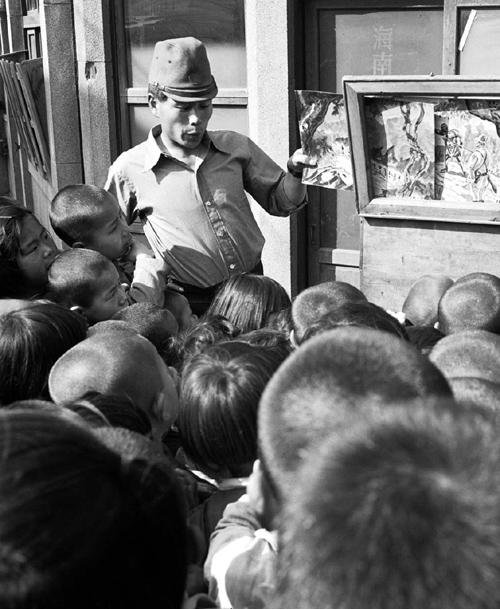Presentation Zen: Simple Ideas on Presentation Design and Delivery, 2nd Edition (Ira Katz's Library) (13 page)
Authors: Garr Reynolds

Photo on this page: Aki Sato, Creative Commons Photo on opposite page: © Horace Bristol/CORBIS

I have seen pretty good (though not great) presentations with average delivery and graphics that were relatively effective because the speaker told relevant stories in a clear, concise manner to support his points in a voice that was human, not formal. Rambling streams of consciousness will not get it done; audiences need to hear (and see) your points illustrated in real language.
Earlier this year, in fact, I saw a fantastic presentation by the CEO of one of the most famous foreign companies in Japan. The CEO’s PowerPoint slides were of mediocre design, and he made the mistake of having not one but two assistants off to the side to advance his slides to match his talk. The assistants seemed to have difficulty with the slideware, and often the wrong slide appeared behind the presenter, but this powerful man simply shrugged his shoulders and said “...ah, doesn’t matter. My point is...” He moved forward and captivated the audience with his stories of the firm’s past failures and recent successes, stories that contained more captivating and memorable practical business lessons than most business students will get in an entire semester or more.
It is true that the presentation would have been even better if the slides had been better designed and used properly, but in this particular case, the CEO gave a powerful and memorable presentation in spite of those shortcomings. Trust me, this is very rare in the world of CEO presentations. There are four essential reasons for his success that night: (1) He knew his material inside and out, and he knew what he wanted to say. (2) He stood front and center and spoke in a real, down-to-earth language that was conversational yet passionate. (3) He did not let technical glitches get in his way. When they occurred, he moved forward without missing a beat, never losing his engagement with the audience. (4) He used real, sometimes humorous, anecdotes to illustrate his points, and all his stories were supremely poignant and relevant, supporting his core message.
What made this CEO’s presentation so compelling and memorable was that it was, above all, authentic. His stories were from his heart and from his gut, not from a memorized script. We do not tell a story from memory alone; we do not need to memorize a story that has meaning to us. If it is real, then it is in us. Based on our research, knowledge, and experience, we can tell it from our gut. Internalize your story, but do not memorize it line by line. You can’t fake it. You believe in your story, or you do not. And if you do not, no amount of hyped-up, superficial enthusiasm or conviction will ever make your time with an audience meaningful. If you do not believe it, do not know it to be true, how can you connect and convince others with your words in story form? Your words will be hollow.

People who possess loads of information in a particular field have historically been in hot demand and able to charge high fees for access to their stuffed, fact-filled brains. This was so because facts used to be difficult to access. Not anymore. In an era when information about seemingly anything is only a mouse click away, just possessing information is hardly the differentiator it used to be. What is more important today than ever before is the ability to synthesize the facts and give them context and perspective. Picasso once said, “Computers are useless for they can only give answers.” Computers and Google can indeed give us routine information and facts we need. What we want from people who stand before us and give a talk is that which data and information alone cannot: meaning.
Remember we are living in a time when fundamental human talents are in great demand. Anyone—indeed any machine—can read a list of features or give a stream of facts to an audience. That’s not what we need or want. What we yearn for is to listen to an intelligent and evocative—perhaps, at times, even provocative—human being who teaches, inspires, or stimulates us with knowledge and meaning, context, and emotion in a way that is memorable.
And this is where story comes in. Information plus emotion and visualization wrapped in unforgettable anecdotes are the stuff that stories are made of. If presentations were only about following a linear, step-by-step formula for distributing information and facts, then no one would be complaining about boring presentations today; after all, the majority of presentations still follow just such a formula. And if designing visuals for your presentation were simply a matter of following a list of rules, then why on earth should we keep wasting our time creating slides and other multimedia? Why not simply outsource our facts, outlines, and bullet points to someone who could do it more cheaply?
But presentations are not just about following a formula for transferring facts in your head to the heads of those sitting before you by reciting a list of points on a screen. (If it were, why not send an e-mail and cancel the presentation?) What people want is something fundamentally more human. They want to hear the story of your facts.
The voice of the storyteller is also important. We pay attention to well-spoken narratives that sound human, that are spoken in a conversational voice. Why do we pay more attention to conversational speech from a storyteller or presenter? It may be because our brain—not our conscious mind—does not know the difference between listening to (or reading) a conversational narrative and actually being in a conversation with a person. When you are in a conversation with someone, you are naturally more engaged because you have an obligation to participate. Formal speech and writing devoid of any emotion is extremely difficult to stay with for more than a few minutes. Your conscious mind has to remind you to “stay awake, this is important!” But someone who speaks in a natural, conversational style is far easier to stay engaged with.

Majora Carter speaks with a “human voice” at the TED Conference in 2005, explaining her fight for environmental justice in the South Bronx. (Photo: TED/leslieimage.com)
Dana Atchley (1941–2000) A Digital Storytelling Pioneer
Dana Atchley was a legend and pioneer in the field of digital storytelling. His clients included Coke, EDS, Adobe, Silicon Graphics, and many others. He even worked with Apple as a charter member of the AppleMasters program. In the ’90s. Atchley was helping senior executives create emotional, compelling talks that used the latest technology to create “digital stories” that connected with and appealed to audiences in a more visceral, visual, emotional, and memorable way. If Atchley had not passed away at age 59 in 2000, presentations—even in the world of business—might be far more appropriate, engaging, and effective today. Here’s what Dana Atchley said about digital storytelling:
“Digital storytelling combines the best of two worlds: the ‘new world’ of digitized video, photography, and art, and the ‘old world’ of telling stories. This means the ‘old world’ of PowerPoint slides filled with bullet point statements will be replaced by a ‘new world’ of examples via stories, accompanied by evocative images and sounds.”
Here’s what Dan Pink, writing for
Fast Company,
said about Dana Atchley and his mission in this excerpt from a 1999 article titled “What’s Your Story?”
“[W]hy does communication about business remain so tedious? Most businesspeople describe their dreams and strategies—their stories—just as they’ve been doing it for decades: stiffly, from behind a podium, and maybe with a few slides. Call it ‘Corporate Sominex.’ Digital storytelling is more than a technique. In fact, it’s become something of a movement among both artists and businesspeople.”
This bit from the
Fast Company
article makes the future of business presentations sound so promising. I get excited reading this and thinking about the possibilities. Yet, since 1999, how much has really changed? Some people today are indeed using digital technology in presentations the way Atchley envisioned. But there is such a long, long way to go before we rid the business world of the “corporate Sominex” phenomenon.
Learn more about Dana Winslow Atchley III and his brilliant contributions on the Next Exit website:
www.nextexit.com
.
The problem with slideware applications—PowerPoint, in particular, because it’s been around longer and influenced a generation—is that they have, by default, guided users toward presenting in outline form with subject titles and bullet points grouped under each topic heading. This is similar to the good ol’ topic sentence in a high school composition class. It seems logical enough, but it is a structure that makes the delivery of the content utterly forgettable for the audience. Storyboarding can help. If you take the time in this part of the preparation stage to set up your ideas in a logical fashion in storyboard format, you can then visualize the sequential movement of your content narrative and the overall flow and feel of the presentation.
Because you have already identified your core message away from the computer, you can now begin to create a storyboard that will give shape to the story of your short presentation. Storyboards have their origins in the movie industry but are used often in business, particularly in the field of marketing and advertising.
One of the simplest and most useful features of PowerPoint and Keynote is the Slide Sorter view (Light Table view in Keynote). You can take your notes and sketches and create a storyboard directly in PowerPoint or Keynote, or you can remain “analog” a bit longer and draft a storyboard on paper or by using Post-its or a whiteboard, etc.
Each situation and each individual is different, and there are indeed many paths to better presentations, including better preparation. My personal approach moving from rough analog sketches to digital slides is not uncommon at all. I have been surprised, however, that for the most part, individual professionals, entrepreneurs, and students usually just open up slideware, type about a dozen subject slides, and then fill them with talking points. This is not an effective approach, nor is it a method I recommend although it is common.
Below is the five-step approach I usually take. I sometimes skip the third and fourth steps, but I find it works well when a group is planning the presentation. For students working on a group presentation, step 3 is vital.
Brainstorming.
Step back, go analog, get away from the computer, tap into the right brain, and brainstorm ideas. You need not show restraint here. Editing comes later. In brainstorming, quantity matters. Here, I put ideas down on cards or sticky notes and place them on a table or whiteboard. This is something you can do by yourself or in a group. When working in a group, do not judge others’ ideas. Simply write them down and place them with the others for the time being. At this stage, even crazy ideas are OK because the offbeat ideas may lead to more practical yet still compelling supporting ideas later on. As the great Linus Pauling once said, “The best way to have a good idea is to have a lot of ideas.”
